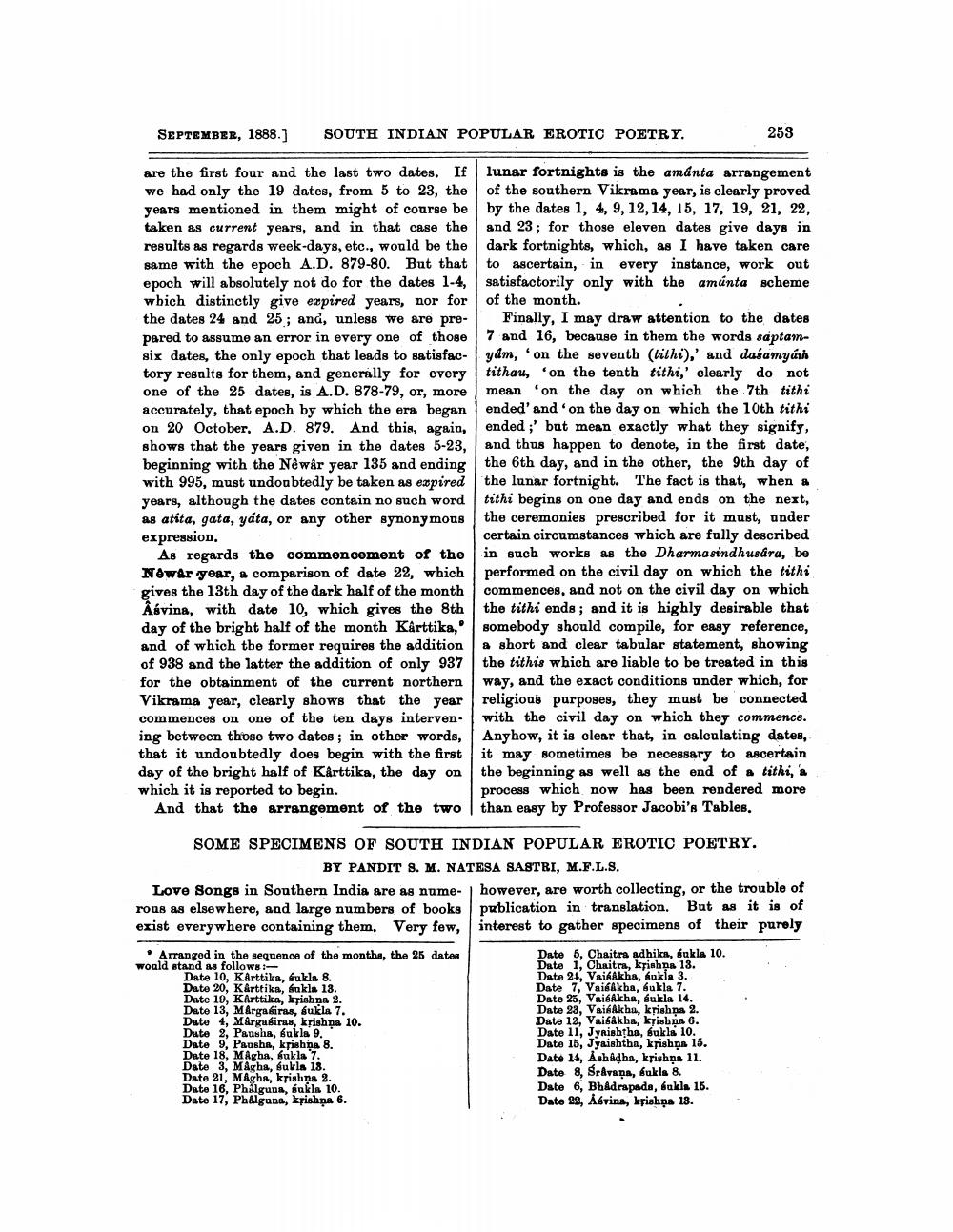________________
SEPTEMBER, 1888.]
are the first four and the last two dates. If we had only the 19 dates, from 5 to 23, the years mentioned in them might of course be taken as current years, and in that case the results as regards week-days, etc., would be the same with the epoch A.D. 879-80. But that epoch will absolutely not do for the dates 1-4, which distinctly give expired years, nor for the dates 24 and 25; and, unless we are prepared to assume an error in every one of those six dates, the only epoch that leads to satisfactory results for them, and generally for every one of the 25 dates, is A.D. 878-79, or, more accurately, that epoch by which the era began on 20 October, A.D. 879. And this, again, shows that the years given in the dates 5-23, beginning with the Nêwâr year 135 and ending with 995, must undoubtedly be taken as expired years, although the dates contain no such word as atita, gata, yáta, or any other synonymous expression.
SOUTH INDIAN POPULAR EROTIC POETRY.
As regards the commencement of the Nowar year, a comparison of date 22, which gives the 13th day of the dark half of the month Âśvina, with date 10, which gives the 8th day of the bright half of the month Kârttika, and of which the former requires the addition of 938 and the latter the addition of only 937 for the obtainment of the current northern Vikrama year, clearly shows that the year commences on one of the ten days intervening between those two dates; in other words, that it undoubtedly does begin with the first day of the bright half of Kårttika, the day on which it is reported to begin.
And that the arrangement of the two
Arranged in the sequence of the months, the 25 dates would stand as follows:
SOME SPECIMENS OF SOUTH INDIAN POPULAR EROTIC POETRY.
BY PANDIT 8. M. NATESA SASTRI, M.F.L.S.
Love Songs in Southern India are as nume- | however, are worth collecting, or the trouble of rous as elsewhere, and large numbers of books publication in translation. But as it is of exist everywhere containing them. Very few, interest to gather specimens of their purely
Date 10, KArttika, éukla 8. Date 20, Karttika, sukla 13. Date 19, KArttika, krishna 2. Date 13, Margasiras, sukla 7. Date 4, Margasiras, krishna 10. Date 2, Pausha, éukla 9. Date 9, Pausha, krishna 8. Date 18, MAgha, ukla 7. Date 3, Magha, éukla 18. Date 21, Magha, krishna 2. Date 16, Phalguna, sukla 10. Date 17, Phalguna, krishna 6.
253
lunar fortnights is the amánta arrangement of the southern Vikrama year, is clearly proved by the dates 1, 4, 9, 12, 14, 15, 17, 19, 21, 22, and 23; for those eleven dates give days in dark fortnights, which, as I have taken care to ascertain, in every instance, work out satisfactorily only with the amúnta scheme of the month.
Finally, I may draw attention to the dates 7 and 16, because in them the words saptamyam, 'on the seventh (tithi),' and daśamyám tithau, on the tenth tithi,' clearly do not mean 'on the day on which the 7th tithi ended' and 'on the day on which the 10th tithi ended;' but mean exactly what they signify, and thus happen to denote, in the first date, the 6th day, and in the other, the 9th day of the lunar fortnight. The fact is that, when a tithi begins on one day and ends on the next, the ceremonies prescribed for it must, under certain circumstances which are fully described in such works as the Dharmasindhusára, be performed on the civil day on which the tithi commences, and not on the civil day on which the tithi ends; and it is highly desirable that somebody should compile, for easy reference, a short and clear tabular statement, showing the tithis which are liable to be treated in this way, and the exact conditions under which, for religious purposes, they must be connected with the civil day on which they commence. Anyhow, it is clear that, in calculating dates, it may sometimes be necessary to ascertain the beginning as well as the end of a tithi, a process which now has been rendered more than easy by Professor Jacobi's Tables.
Date 5, Chaitra adhika, śukla 10. Date 1, Chaitra, krishna 13. Date 24, Vaisakha, sukia 3. Date 7, Vaisakha, 6ukla 7. Date 25, Vai6Akha, sukla 14. Date 23, Vaisakha, krishna 2. Date 12, Vaisakha, krishna 6. Date 11, Jyaishtha, sukla 10. Date 15, Jyaishtha, krishna 15. Date 14, Ashadha, krishna 11. Date 8, Sravana, Sukla 8. Date 6, Bhadrapada, éukla 15. Date 22, Aévina, krishna 13.




